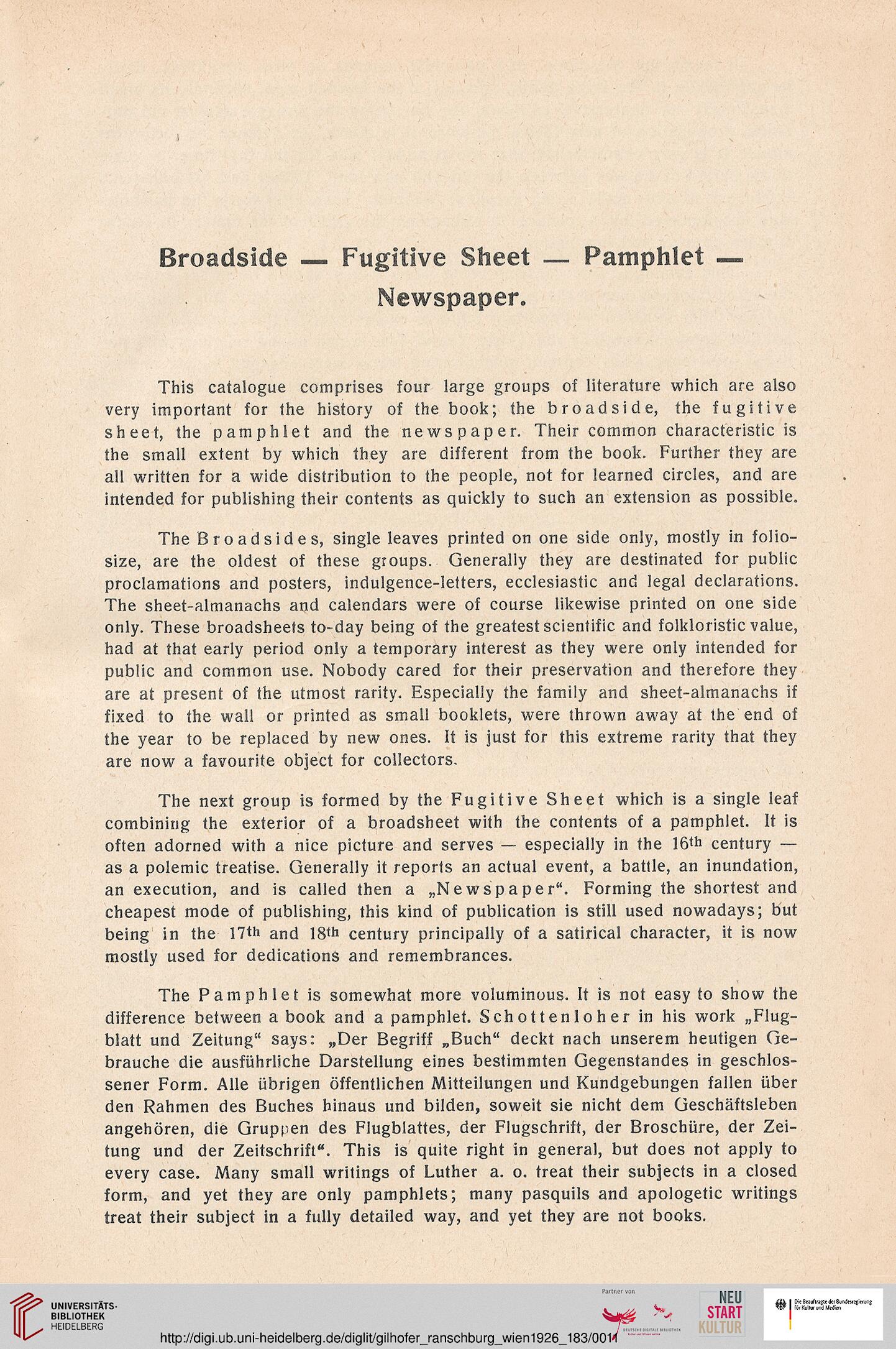Broadside — Fugitive Sheet — Pamphlet —
Newspaper.
This catalogue comprises four large groups of literature which are also
very important for the history of the book; the broadside, the fugitive
sheet, the pamphlet and the newspaper. Their common characteristic is
the small extent by which they are different from the book. Further they are
all written for a wide distribution to the people, not for learned circles, and are
intended for publishing their contents as quickly to such an extension as possible.
The Broadsides, single leaves printed on one side only, mostly in folio-
size, are the oldest of these groups. Generally they are destinated for public
proclamations and posters, indulgence-letters, ecclesiastic and legal declarations.
The sheet-almanachs and calendars were of course likewise printed on one side
only. These broadsheets to-day being of the greatest scientific and folkloristic value,
had at that early period only a temporary interest as they were only intended for
public and common use. Nobody cared for their preservation and therefore they
are at present of the utmost rarity. Especially the family and sheet-almanachs if
fixed to the wall or printed as small booklets, were thrown away at the end of
the year to be replaced by new ones, it is just for this extreme rarity that they
are now a favourite object for collectors.
The next group is formed by the Fugitive Sheet which is a single leaf
combining the exterior of a broadsheet with the contents of a pamphlet. It is
often adorned with a nice picture and serves — especially in the 16th century —
as a polemic treatise. Generally it reports an actual event, a battle, an inundation,
an execution, and is called then a ..Newspaper*. Forming the shortest and
cheapest mode of publishing, this kind of publication is still used nowadays; but
being in the 17th and 18th century principally of a satirical character, it is now
mostly used for dedications and remembrances.
The Pamphlet is somewhat more voluminous. It is not easy to show the
difference between a book and a pamphlet. Sch often lo her in his work „Flug-
blatt und Zeitung" says: „Der Begriff „Buch“ deckt nach unserem heutigen Ge-
brauche die ausfiihrliche Darstellung eines bestimmten Gegenstandes in geschlos-
sener Form. Alle iibrigen offentlichen Mitteilungen und Kundgebungen fallen liber
den Rahmen des Buches hinaus und bilden, soweit sie nicht dem Geschaftsleben
angehdren, die Gruppen des Flugblattes, der Flugschrift, der Broschiire, der Zei-
tung und der Zeitschrift". This is quite right in general, but does not apply to
every case. Many small writings of Luther a. o. treat their subjects in a closed
form, and yet they are only pamphlets; many pasquils and apologetic writings
treat their subject in a fully detailed way, and yet they are not books.
Newspaper.
This catalogue comprises four large groups of literature which are also
very important for the history of the book; the broadside, the fugitive
sheet, the pamphlet and the newspaper. Their common characteristic is
the small extent by which they are different from the book. Further they are
all written for a wide distribution to the people, not for learned circles, and are
intended for publishing their contents as quickly to such an extension as possible.
The Broadsides, single leaves printed on one side only, mostly in folio-
size, are the oldest of these groups. Generally they are destinated for public
proclamations and posters, indulgence-letters, ecclesiastic and legal declarations.
The sheet-almanachs and calendars were of course likewise printed on one side
only. These broadsheets to-day being of the greatest scientific and folkloristic value,
had at that early period only a temporary interest as they were only intended for
public and common use. Nobody cared for their preservation and therefore they
are at present of the utmost rarity. Especially the family and sheet-almanachs if
fixed to the wall or printed as small booklets, were thrown away at the end of
the year to be replaced by new ones, it is just for this extreme rarity that they
are now a favourite object for collectors.
The next group is formed by the Fugitive Sheet which is a single leaf
combining the exterior of a broadsheet with the contents of a pamphlet. It is
often adorned with a nice picture and serves — especially in the 16th century —
as a polemic treatise. Generally it reports an actual event, a battle, an inundation,
an execution, and is called then a ..Newspaper*. Forming the shortest and
cheapest mode of publishing, this kind of publication is still used nowadays; but
being in the 17th and 18th century principally of a satirical character, it is now
mostly used for dedications and remembrances.
The Pamphlet is somewhat more voluminous. It is not easy to show the
difference between a book and a pamphlet. Sch often lo her in his work „Flug-
blatt und Zeitung" says: „Der Begriff „Buch“ deckt nach unserem heutigen Ge-
brauche die ausfiihrliche Darstellung eines bestimmten Gegenstandes in geschlos-
sener Form. Alle iibrigen offentlichen Mitteilungen und Kundgebungen fallen liber
den Rahmen des Buches hinaus und bilden, soweit sie nicht dem Geschaftsleben
angehdren, die Gruppen des Flugblattes, der Flugschrift, der Broschiire, der Zei-
tung und der Zeitschrift". This is quite right in general, but does not apply to
every case. Many small writings of Luther a. o. treat their subjects in a closed
form, and yet they are only pamphlets; many pasquils and apologetic writings
treat their subject in a fully detailed way, and yet they are not books.



